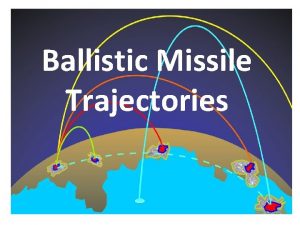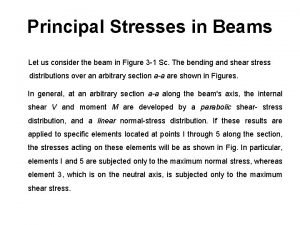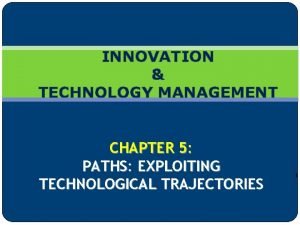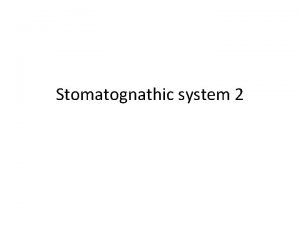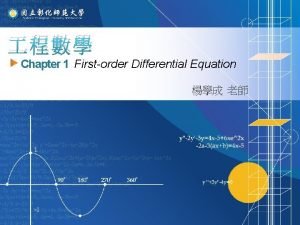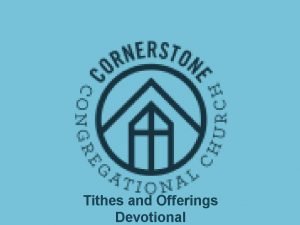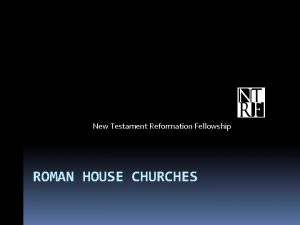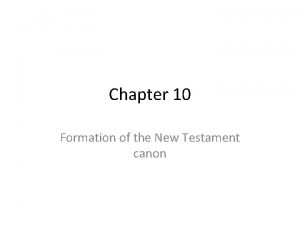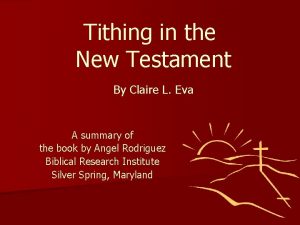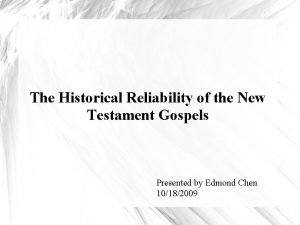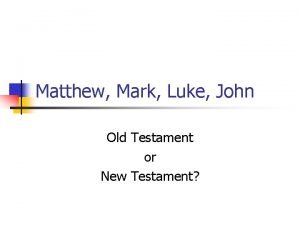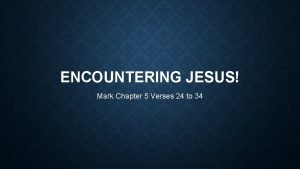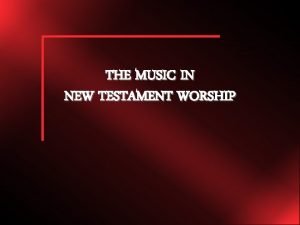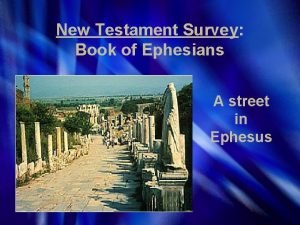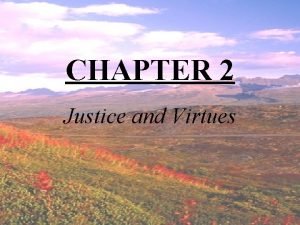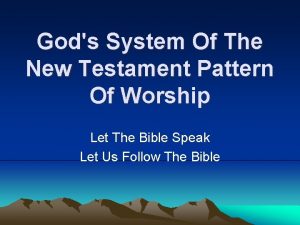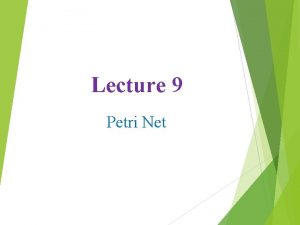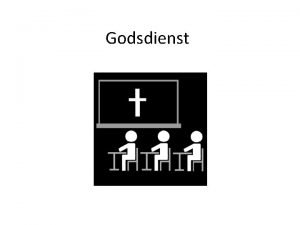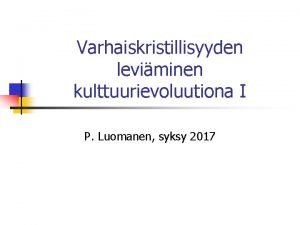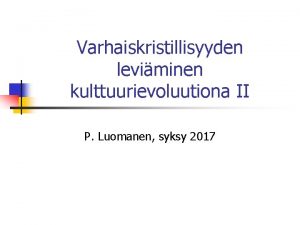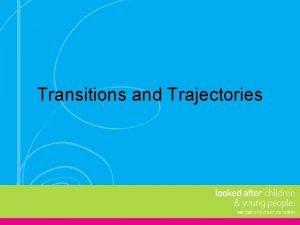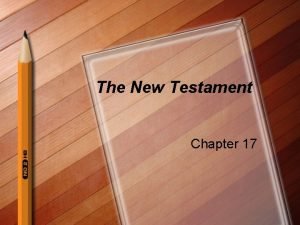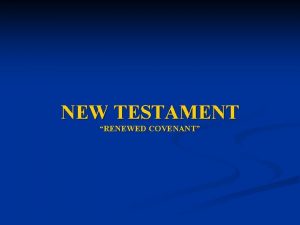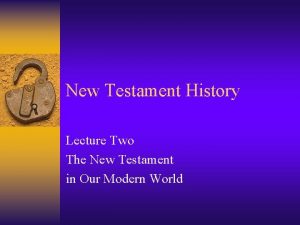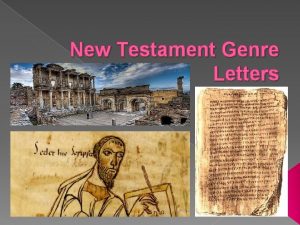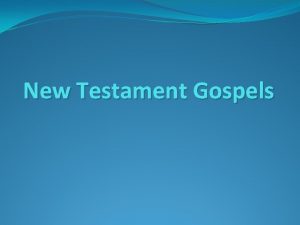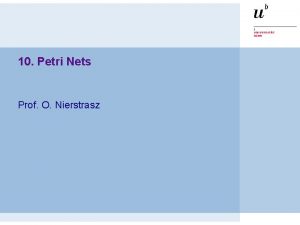Trajectories in New Testament Studies Today Petri Luomanen






















- Slides: 22

Trajectories in New Testament Studies Today Petri Luomanen 16. 02. 2010

What is a trajectory? • Two basic meanings in English: – the path of a moving object (ball, bullet, rocket) when it moves through air – path, progression, line of development

James M. Robinson and Helmut Koester: Trajectories Through Early Christianity (Fortress Press, 1971)

Robinson’s and Koester’s Trajectories Key topics of the lecture: “ A bird’s eye view” (see the handouts): A) What is the present Judaism and Hellenism are not paradigm? Are there trajectories that challenge the paradigm? static backgrounds B) How trajectories are generated? Where they come from? What are the impulses? Attention tothe movements, C) What is hermeneutical“trajectories” relevance of themoving trajectories? canonical and non-canonical literature. • • in The concept of trajectories problematic As a starting point for today’s topic: 1)R & K’s trajectories challenge the existing paradigm 2)R & K also have an hermeneutical edge: “Relevance” only emerges where there is the courage to follow new trajectories which take into account the complexity of historical developments. (Koester, Trajectories, p. 270) 3) How “trajectories” are born in Biblical studies?

Trajectories in New Testament Studies Today? • An area of study (or several areas) in NT research that you find new, interesting, or representing ”cutting edge” scholarship. • An interesting book, or an article in the area of NT studies that you have read / hear of

Today’s trajectories? Johannin e studies? Pauline studies? Jesus research? Q and synoptics ? Noncanonical texts?

Today’s trajectories? Johannin e studies? Pauline studies? Jesus research? Q and synoptics ? Noncanonical texts?

Today’s trajectories? Research generated trajectories Cultural trajectories Methodological trajectories Johannin e studies? Pauline studies? Q and synoptics ? Jesus research? Noncanonical texts?

Cultural trajectories (post-modern) Post-holocaust self-reflection Øre-evaluation of Judaism Ø “new perspective on Paul” Ø “re-Judaization” of NT at large Linguistic turn Social constructionism Intrest in identity Research generated trajectorie Methodological trajectories

Research generated trajectories Cultural trajectories Methodological trajectories Archaeological discoveries Nag Hammadi Qumran ØRe-evaluation of Second Temple Judaism ØRe-evaluation early Christianity

Methodological trajectories A) Historical-critical paradigm B) Text-oriented / linguistic paradigm C) Social- and behavioral science paradigm D) Ideological / Intercontextual paradigm

A) Historical-critical paradigm – – – Archaeology; Biblical archaeology 1920 s-1940 s Textual criticism (tracing the ”original” text form) Literary criticism (source criticism) Form criticism (form=> genre => Sitz im Leben) Tradition history Redaction criticism B) Text-oriented / linguistic paradigm C) Social- and behavioral science paradigm D) Ideological / Intercontextual paradigm

A) Historical-critical paradigm – – – (development since 1970 s) Reception history, effective history Focus on orality, secondary orality, aurality, performance – recently connected to social memory and critical discussion about the legacy of from criticism Critical discussion of concepts: Gnosticism (Michael A. Williams), Jewish Christianity Texts as artifacts (Larry Hurtado), instead of “original” text forms focus also on the history of manuscripts and readings. Digital imagining. NOTE: also other paradigms can be historically oriented: For instance: social science, ancient rhetoric etc.

B) Text-oriented / linguistic paradigm (ca. 1970 -1995) – Structuralism, end of 1960 s, beginning of 1970 s (Ferdinand de Saussure; Claude Levi-Strauss; synchronic description of the structure of the text => binary opposiotions). – Text linguistics – Rhetorical criticism (ancient and modern) – Narrative criticism – Reader response criticism

B) Text-oriented / linguistic paradigm (ca. 1995 -) – Cognitive linguistics, blending theory (Fauconnier and Turner, 1996) – Integration with social science approach: Sociorhetorical criticism: Vernon K. Robbins, The Tapestry of Early Christian Discourse 1996 [started already 1984, with Mark] http: //www. religion. emory. edu/faculty/robbins/ind ex. cfm – Integration of ancient and modern rhetorical criticism

C) Social- and behavioral science paradigm (ca 1975 -1995) – Social science approach (towards the end of 1970 s): • Social history • Social-scientific criticism (application of social science theories and models): functionalism (Theissen), sociology of knowledge, sectarian studies, etc. • Cultural anthropology (Mediterranean; Malina) – Archaeology • [Biblical archaeology 1920 -1940] • “New Archaeology” from 1960 s onwards: Increasing integration with social and natural sciences – Psychological exegesis (Theissen, 1983; Drewerman 1980 s and 1990 s)

Cognitive science of religion • Since 1990 s in comparative religion • Draws on cognitive science, cognitive and developmental psyhology, and neuroscience, C) Socialbehavioral science evolutionary biology, anthropology paradigm (ca. 1995 -) • Contagious ideas (cf. Dawkin’s memes) • Rituals and development of religions – Social psychology. Henri Tajfel’s social identity (Whitehouse, Lawson and Mc. Cauley) theory + self-categorization theory = social identity approach; Philip Esler 1998, 2003. – Cognitive science of religion; cognitive science and cognitive psychology in general; Luomanen, Uro & Pyysiäinen, 2007. – Social memory; drawing on Maurice Halbwachs (d. 1945); Kirk & Thatcher 2005; Kelber & Byrskog 2009 (a review of B. Gerhardsson’s contribution)

D) Ideological / Intercontextual paradigm (ca. 1970 -1995) – Liberation theology and hermeneutics in Latin America, from 1970 s onwards (Gustavo Gutiérrez, 1972) – Feminist criticism (Elisabeth Schüssler Fiorenza 1983) – Post-colonial criticism – Canonical criticism (Breward Childs)

D) Ideological / Intercontextual paradigm (cs. 1995 -) • Gender studies – Queer theory – LGBT • Contextual hermeneutics (SBL AM Program units) – – – – African Biblical Hermeneutics African and African-American hermeneutics Asian and Asian-American hermeneutics Contextual Biblical Interpretation Ideological Criticism (focuses on politics) Islands, Islanders, and Bible Korean Biblical Colloqium Latino/a and Latin American Biblical Interpretation

6: The future direction of New Testament studies • Situation much more diverse than by the time when R&K introduced their ”trajectories” • Some overall trends detect- and predictable: – Multi- and interdisciplinarity calls for and generates integration (cf. Robbins, Syreeni’s model of three worlds) – Growing impact from Asian and African Christianity – Need for contextualisation, ”relevance” grows also within Western Biblical scholarship

Recategorizations within New Testament studies in the air? • Inter- and multidisciplinarity also leads to fruitful integration with natural sciences and empirical research? – Cognitive sciences provide scientifically tested knowledge about functions of human mind. This replaces exegetical ”arm chair psychology”? It is time for ”theology in the flesh”?

Trajectories in New Testament Studies Today • Did you find a place for your ”own” trajectory, book, article or interesting topic? • Other questions?
 Scud missile engine
Scud missile engine Principal stress trajectories
Principal stress trajectories 5 major technological trajectories
5 major technological trajectories Buccinator mechanism muscles
Buccinator mechanism muscles Orthogonal trajectories
Orthogonal trajectories Encouragement about giving tithes and offering
Encouragement about giving tithes and offering House churches in the new testament
House churches in the new testament Tithe in new testament
Tithe in new testament Encountering jesus in the new testament answer key
Encountering jesus in the new testament answer key Encountering jesus in the new testament
Encountering jesus in the new testament Greek word canon
Greek word canon Tithing in the new testament
Tithing in the new testament The historical reliability of the gospels
The historical reliability of the gospels Test: the general epistles new testament survey
Test: the general epistles new testament survey New testament reformation fellowship
New testament reformation fellowship Matthew mark luke john books of the bible
Matthew mark luke john books of the bible Encountering jesus in the new testament
Encountering jesus in the new testament Titus in the bible summary
Titus in the bible summary Instrumental music in new testament worship
Instrumental music in new testament worship New testament survey book
New testament survey book Justice and virtue
Justice and virtue 27 new testament books
27 new testament books New testament pattern of worship
New testament pattern of worship
